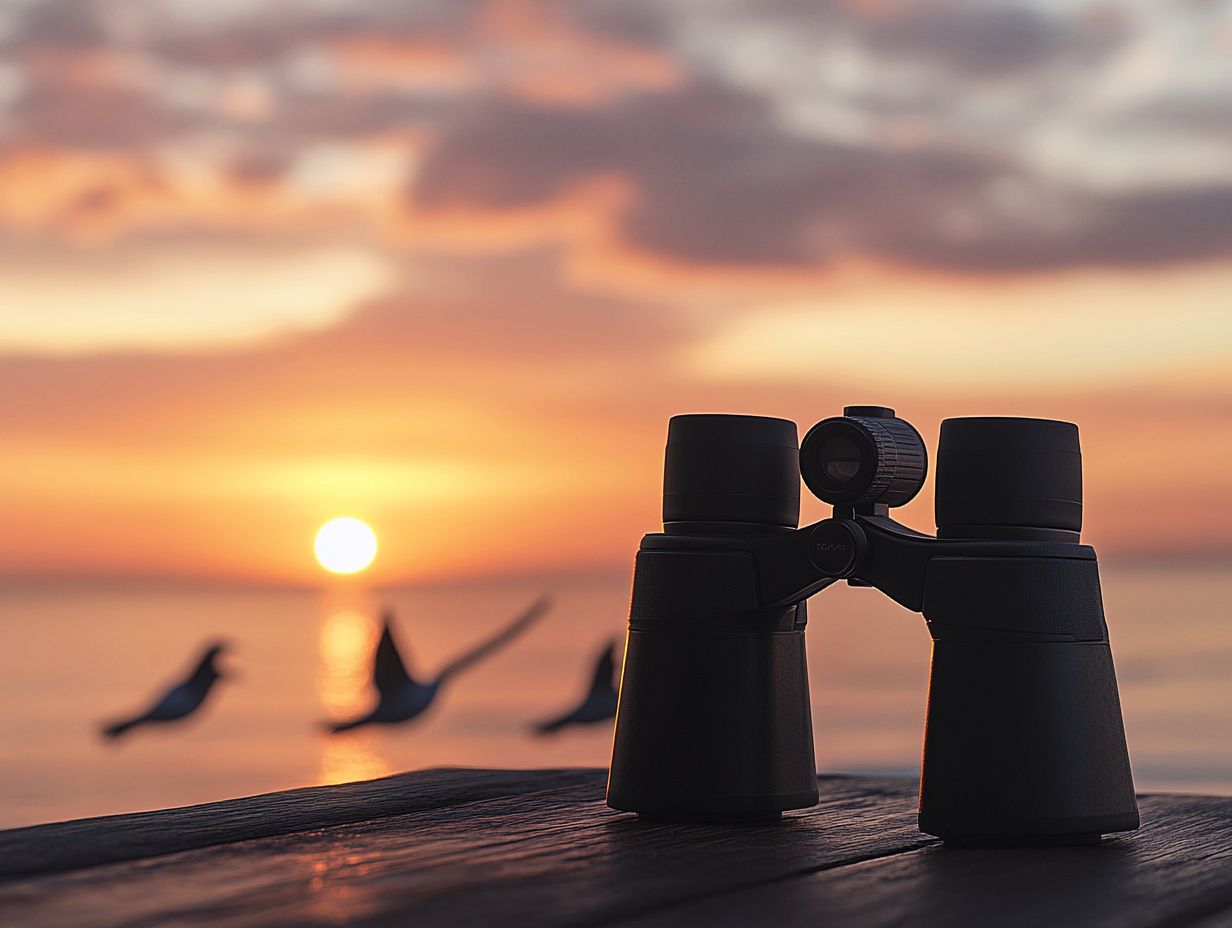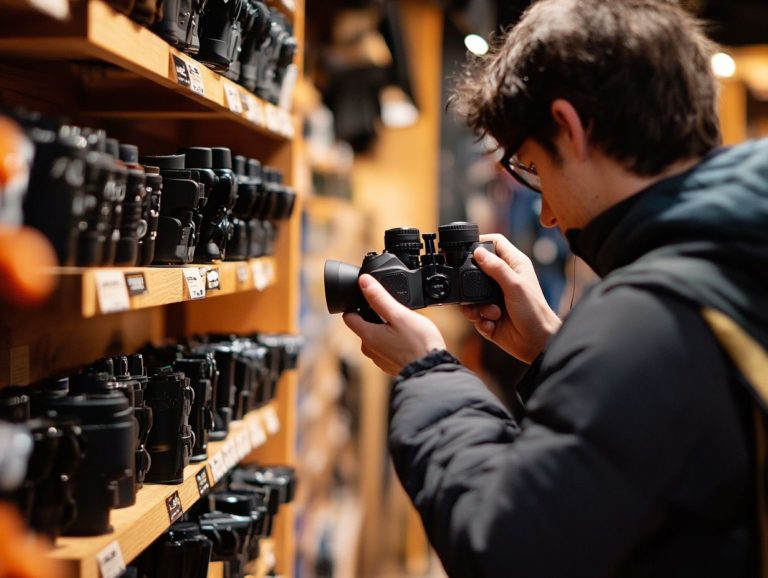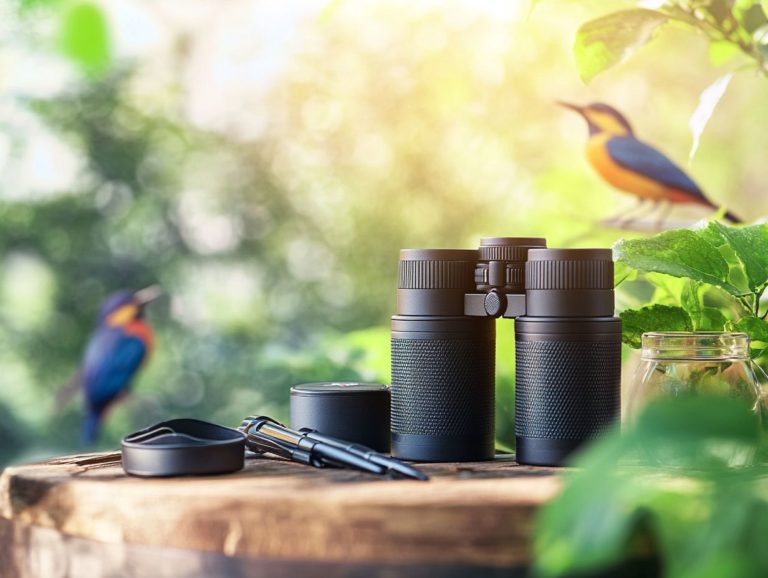The Best Binoculars for Twilight Bird Watching
As the sun dips below the horizon and nature gracefully transitions into twilight, birdwatching reveals a captivating allure that beckons you. To fully immerse yourself in this tranquil experience, possessing the right binoculars becomes essential.
This article delves into the key features that make binoculars optimal for twilight birdwatching, covering aspects such as magnification power, Objective Lens size, low-light performance, and image quality.
You’ll also discover valuable tips for maintaining your gear, along with a spotlight on reputable brands. Get ready to transform your birdwatching into an unforgettable experience!
Contents
- Key Takeaways:
- 1. Magnification Power
- 2. Objective Lens Size
- 3. Field of View
- 4. Close Focus Distance
- 5. Image Quality
- 6. Low-Light Performance
- 7. Durability and Weather Resistance
- 8. Weight and Size
- 9. Ease of Use
- 10. Price
- What Makes Binoculars Ideal for Twilight Bird Watching?
- What Are the Key Features to Look for in Binoculars for Twilight Bird Watching?
- How Do Different Types of Coatings Affect Image Quality?
- What Are Some Recommended Brands for Twilight Bird Watching Binoculars?
- What Are Some Common Mistakes to Avoid When Choosing Binoculars for Twilight Bird Watching?
- How Can One Properly Care for and Maintain Their Binoculars?
- Frequently Asked Questions
- What are the best binoculars for twilight bird watching?
- Why is a wide field of view important for twilight bird watching?
- What does magnification power have to do with twilight bird watching?
- How does low light performance affect binoculars for twilight bird watching?
- Do I need to consider the weight of the binoculars for twilight bird watching?
- Are there any additional features that are helpful for twilight bird watching?
Key Takeaways:

- Choose binoculars with higher magnification power, such as 8x or 10x, to observe birds with better detail and clarity during twilight hours.
- Select binoculars with larger Objective Lens sizes, around 42mm or higher, to gather more light and improve visibility in low-light conditions.
- Opt for a wide field of view, typically above 300 ft at 1000 yards, to easily locate and track birds, especially during fast movements in low light.
1. Magnification Power
Magnification power plays a pivotal role in your binocular experience, especially when you’re out birdwatching. It allows you to catch the finer details of distant species like sandhill cranes and snow geese with unparalleled clarity.
Choosing the right level of magnification enhances how well you see through them. It also influences your field of view and image stability during those outdoor adventures.
Higher magnification levels enable you to see intricate feather patterns and subtle color variations essential for identifying bird species that look remarkably similar. Keep in mind that as magnification increases, the image might become a bit wobbly, which means you’ll need steadier hands or perhaps the support of a tripod a support for steady viewing.
For spotting birds nestled in dense foliage, a lower magnification, like 8x, is often ideal, as it offers a wider field of view. In more open areas where you can appreciate finer details, consider going with a 10x or even a 12x magnification.
Ultimately, your choice should align with the specific environment where you plan to observe, striking a balance between image resolution and ease of handling.
2. Objective Lens Size
The size of the Objective Lens in binoculars is crucial for determining optical performance, particularly in terms of light transmission. This feature allows you, as a birdwatcher, to excel in low-light conditions, enriching your bird identification experience during those enchanting twilight hours.
Larger Objective Lenses enhance light-gathering capabilities, resulting in sharper and more vibrant images even when the lighting isn t perfect. This advantage is especially helpful when you’re trying to spot elusive species in dense forests at dusk.
Vortex Razor binoculars, while also featuring ample Objective Lenses, come with advanced coatings that further enhance light transmission and minimize glare. Whether you re out in bright daylight or navigating challenging conditions like viewing against a reflective water surface both models enable you to see intricate details with exceptional clarity.
Ultimately, selecting the right binoculars can greatly elevate your viewing experience, ensuring that every bird sighting becomes a cherished memory.
3. Field of View
The field of view in binoculars is a vital specification for you as a bird watcher. A wider field of view lets you see more of the sky, making it easier to track moving birds like sandhill cranes and snow geese while maintaining optimal image quality.
Understanding this specification is particularly important when selecting binoculars. For instance, popular models like the Swarovski NL Pure offer a wider field of view compared to the Maven C.1. If you enjoy birding in open landscapes or during migration seasons, a wider field can significantly enhance your experience. Consider the types of birds you typically observe and the environments you frequent, as this will inform your choice.
Experimenting with different models helps you find the perfect balance between field of view and magnification that suits your personal preferences. This way, every outing can be both enjoyable and productive.
4. Close Focus Distance
Close focus distance is essential in binoculars, allowing you to marvel at nearby plants and animals with incredible clarity especially during events like the Audubon Nebraska Crane Festival.
This feature lets you focus on subjects just a few feet away, opening up a new world for identifying smaller birds or elusive insects hidden in thickets. Imagine wandering through a vibrant garden and catching sight of a tiny hummingbird or a butterfly resting delicately on a flower details that would easily slip past without the right equipment.
Binoculars like the Zeiss SFL series are renowned for their superb close focus capabilities, while the Hawke Frontier models excel in clarity at short distances. These advancements in optics enhance your experience and improve your identification accuracy, transforming each birding outing into a rewarding adventure.
5. Image Quality
Image quality is crucial in binocular performance, directly influencing the optical clarity and overall viewing experience for you as a bird watcher. It allows you to appreciate the intricate details of species like prairie chickens in their natural habitats.
High-definition glass and premium optical components play key roles in enhancing this quality, delivering sharper and more vibrant images. For instance, binoculars equipped with advanced lens coatings significantly reduce glare and improve light transmission, enabling you to capture finer details even in challenging lighting conditions.
When comparing popular models like the Leica Trinovid and Steiner HX, you’ll notice distinct variations in color richness and contrast. While the Trinovid dazzles with its remarkable clarity, the Steiner HX shines with a robust and rugged design that’s perfect for your outdoor adventures. Ultimately, your choice will depend heavily on your specific viewing needs.
6. Low-Light Performance

Low-light performance is vital for you as a bird watcher who ventures out at dawn or dusk. It determines how effectively your binoculars can gather light and produce clear images of elusive species during challenging conditions, making premium binoculars critical for serious birding enthusiasts.
The optical features that enhance this performance include the size of the objective lens and specialized coatings applied to the glass. A larger objective lens captures more light, which is key for spotting birds when it s dim. Meanwhile, high-quality coatings, like multi-coatings and phase correction, work to reduce glare and enhance color fidelity.
When comparing different models, some may excel in light-gathering ability. For example, a model with a 42mm objective lens and superior coatings might outperform a standard 32mm model in twilight conditions, offering you sharper, brighter images of birds as they flit through the shadows.
7. Durability and Weather Resistance
For you, the passionate bird watcher, durability and weather resistance are essential features in your binoculars. These qualities ensure that your gear can withstand a variety of outdoor conditions. This allows for reliable mechanical performance and optical clarity during those long hours spent observing your feathered friends.
The secret to this resilience lies in the rugged construction techniques and high-quality materials that are essential for your binoculars. Take, for example, binoculars crafted with a magnesium-alloy chassis; they offer a lightweight yet robust framework. This makes it easier for you to handle them during extended viewing sessions.
Waterproof capabilities are also crucial for navigating unexpected weather changes. They allow you to remain immersed in your passion without missing a beat. Brands like Vortex Optics offer exceptional craftsmanship, featuring nitrogen-purged lenses (which prevent fogging). Meanwhile, Hawke Frontier models provide the robust construction necessary to endure harsh environments, proving that these tools are more than capable of keeping up with the demands of serious bird watching.
8. Weight and Size
The weight and size of binoculars can greatly impact your bird-watching experience. Lightweight models are a dream to carry over long distances. They offer the comfort you need during those extended hours of observation.
However, it s crucial to find a balance. Compact models may seem convenient, but they often fall short in performance, especially in light-gathering ability and image stability. If you re an avid hiker, you might favor a compact option that reduces bulk, allowing for easy mobility.
Conversely, if you stay in one spot to observe, you might prefer a larger, heavier pair. These can provide superior image clarity and brightness, giving you breathtaking views of distant birds.
Ultimately, selecting the right binoculars means understanding these trade-offs, tailored to your specific activities and preferences.
9. Ease of Use
Ease of use is paramount for bird watchers like you. Ergonomic designs and intuitive features think smooth focus wheels and comfortable eye relief allow for quick adjustments to your binoculars. This ensures you don t miss those fleeting moments in nature.
Adjustable eyecups are a game changer for those who wear glasses. They enable you to enjoy a full field of view without sacrificing comfort. The overall design greatly influences how long you can comfortably observe, allowing you to indulge in your passion without discomfort.
When comparing user-friendly models, you ll notice that many brands have opted for lightweight materials and balanced designs. These reduce fatigue during those marathon observation sessions. This meticulous attention to design, paired with effective focus mechanisms, elevates your experience and boosts your chances of capturing those magical moments in the wild.
Ultimately, these carefully crafted features empower you to immerse yourself fully in the captivating world of avian life.
10. Price
The price of binoculars can vary significantly, influencing the experience of bird watchers like you. It s essential to strike a balance between budget-friendly options and premium models, like the Swarovski NL Pure. This ensures you achieve the best optical performance without stretching your finances too far.
When assessing binoculars, consider critical factors like magnification power, lens diameter, and overall build quality. Performance measured by clarity, color fidelity, and low-light capabilities plays a pivotal role in determining whether your investment is truly worthwhile.
It’s wise to evaluate additional features, like waterproofing, ergonomic design, and warranty options. These can enhance your overall usability.
By pinpointing your specific needs whether you re a casual birdwatcher or a serious wildlife observer you’ll be thrilled to make informed choices that deliver lasting satisfaction without compromising on quality. This thoughtful evaluation guides you in selecting the right model and ensures an enriching viewing experience every time you head out. Don t wait! Choose the right binoculars today for an enriching experience!
What Makes Binoculars Ideal for Twilight Bird Watching?
Binoculars perfect for twilight bird watching offer an exceptional blend of how well you can see through them and superior capabilities in dim light. For those interested in finding the best options, check out the top 10 most popular binoculars for bird watching. This ensures you can identify elusive species like sandhill cranes at dawn or dusk with remarkable clarity, elevating your outdoor experience to new heights!
These specialized tools often come equipped with advanced lens coatings that enhance light transmission and reduce glare. This allows you to maximize visibility during those dim conditions. A larger objective lens size is crucial, as it gathers more light, enabling detailed observations even as the light begins to fade.
For those in pursuit of top-tier options, models like the Nikon Monarch 7 10×42 and the Swarovski EL 10×42 truly stand out. They provide excellent visibility and contrast, making them ideal for spotting distant birds as the sun dips low on the horizon. With such remarkable choices, you won t miss a single fleeting moment!
What Are the Key Features to Look for in Binoculars for Twilight Bird Watching?

When you’re choosing binoculars for twilight bird watching, it’s essential to focus on key features like optical clarity, low-light performance, and close focus distance. For those interested in the best options, consider the top 5 innovative binoculars for bird watching. These elements are critical for anyone eager to spot species in those enchanting low-light conditions.
These features elevate your viewing experience and help you accurately identify various bird species during magical moments as daylight fades. For example, binoculars with higher magnification and large objective lenses, like the Nikon Monarch 7, offer exceptional light transmission.
This allows you to see vibrant colors and crisp details, even as dusk settles in. Models like the Zeiss Terra ED have a close focus distance that s perfect for observing birds near foliage, letting you capture every subtle movement with ease.
By prioritizing these must-have features, you ll dive into the tranquil beauty of twilight, making your observations truly memorable!
How Do Different Types of Coatings Affect Image Quality?
Different coatings on binocular lenses can profoundly influence image quality and overall optical performance. It s essential for you, as a bird watcher, to understand these coatings when selecting premium optics for your adventures.
These coatings are pivotal in reducing glare and enhancing light transmission. They can significantly improve visibility during those magical early morning or late evening outings. For example, anti-reflective coatings minimize unwanted reflections that can cloud your view, delivering brighter and clearer images of distant subjects.
Phase-correction coatings take it a step further, enhancing contrast and sharpness especially in roof-prism models by perfectly aligning each light wave. When comparing models equipped with these advanced technologies, you ll discover vast differences in performance, giving you the power to make informed choices tailored to your specific viewing needs.
What Are Some Recommended Brands for Twilight Bird Watching Binoculars?
For twilight bird watching, you’ll want to consider brands that come highly recommended for their dedication to crafting premium binoculars. To find out more about which models excel in low-light capabilities and optical clarity, check out this guide on the best binoculars for bird watching trips. This commitment takes your bird-watching experience to a whole new level!
Nikon shines with its Monarch series, and the Monarch HG in particular stands out for its remarkable field of view and vibrant colors, even in dimmer conditions. Swarovski excels with its SLC series, which boasts high transmission optics that make low-light observations incredibly sharp and detailed.
Vortex, known for its rugged and dependable products, offers the Viper HD, equipped with advanced lens coatings that maximize brightness. Together, these brands provide a diverse array of options, perfectly catering to your quest for optimal performance while observing birds at twilight!
What Are Some Common Mistakes to Avoid When Choosing Binoculars for Twilight Bird Watching?
When selecting binoculars for twilight bird watching, it’s easy to make mistakes such as overlooking optical specifications, neglecting low-light performance, or failing to consider the weight. To avoid these pitfalls, check out the top 5 binoculars for bird watching under $200.
These oversights can significantly diminish your birding experience. To truly elevate your adventures, take the time to evaluate key factors like magnification and lens diameter; these elements are crucial for achieving image clarity and brightness during those enchanting dusk hours.
Ergonomics should also be a priority, as the weight and grip of the binoculars will greatly influence your comfort during extended periods of use. Don t underestimate the importance of features like waterproofing and fog resistance; they can mean the difference between a seamless outing and an inconvenient interruption.
By aligning the specifications with your personal preferences and typical usage conditions, you can ensure that your choice of binoculars enhances your passion for observing birds.
How Can One Properly Care for and Maintain Their Binoculars?
Proper care and maintenance of your binoculars are essential for ensuring their longevity and optimal performance.
This allows you to enjoy clear views and reliable operation during your outdoor adventures. Taking a few moments for routine checks and cleanings can transform your viewing experience. Regularly inspect the lenses for dust or smudges, as these can obstruct your vision.
A gentle wipe with a microfiber cloth is often all it takes to restore clarity. When you’re not using them, store your binoculars in a protective case or padded pouch to prevent damage from impacts or moisture.
Familiarizing yourself with the specific materials in high-quality binoculars such as multi-coated lenses and weather-resistant housing will help you choose the right cleaning solutions and techniques. This attention to detail ensures that your trusted companions remain in prime condition for countless adventures ahead.
Frequently Asked Questions
What are the best binoculars for twilight bird watching?

The best binoculars for twilight bird watching are those that have a wide field of view, high magnification power, and excellent low-light performance. For those specifically looking for options suitable for urban environments, consider checking out the top binoculars for bird watching in urban areas, such as the Nikon Monarch 5 8×42, Vortex Diamondback HD 8×42, and Zeiss Conquest HD 8×42.
Why is a wide field of view important for twilight bird watching?
A wide field of view allows you to see more of your surroundings and spot birds in their natural habitat more easily, especially during twilight when lighting conditions are lower.
What does magnification power have to do with twilight bird watching?
Magnification power lets you see birds up close, which is especially helpful during twilight. A higher magnification power is recommended as it allows for better detail and clarity in low-light conditions.
How does low light performance affect binoculars for twilight bird watching?
Low light performance refers to a binocular’s ability to provide a clear and bright image in low light conditions. This is crucial for twilight bird watching as it allows for better visibility and detail in dim lighting.
Do I need to consider the weight of the binoculars for twilight bird watching?
Yes, weight is an important factor to consider. You will likely be holding them for extended periods, so choose a lightweight option that won’t strain your arms and hands.
Are there any additional features that are helpful for twilight bird watching?
Some additional features to look for include anti-reflective coatings, waterproof and fog-proof construction, and a close focus distance of at least 6 feet. These features can enhance your bird watching experience and make it easier to spot birds during twilight hours.






